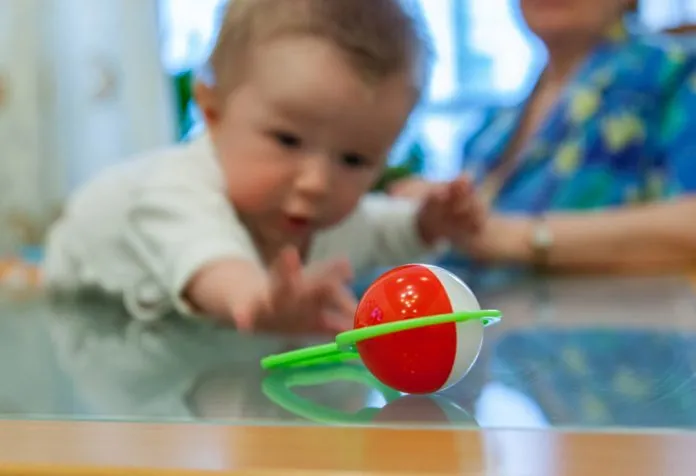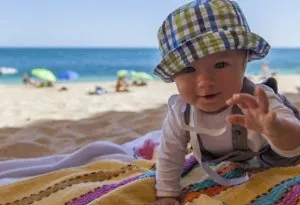At What Age Is a Baby Able to Grasp With Its Thumb and Fingers?


At FirstCry Parenting, our aim is to give you the most elevant, accurate and up to date information.
Every article that we publish, confirms to stringent guidelines & involves several levels of reviews, both from our Editorial team & Experts. We welcome your suggestions in making this platform more useful for all our users. Write in to us at parenting.care@firstcry.com

- Video: Pincer Grasp in Babies –A Significant Milestone in Child Development
- What Is Pincer Grasp?
- Pincer Grasp Development in Babies
- What if Your Baby Doesn't Develop Pincer Grasp?
- Activities to Help Your Baby Develop Pincer Grasp
- Toys to Encourage Pincer Grasp Development
- What Will Happen Once Your Child Develops the Pincer Grasp?
Last Updated on
Many parents look out for signs like rolling, crawling and walking to mark the development milestones of their baby. There may be one significant development that you may tend to overlook as being vital to your baby's growth – the pincer grasp. Learning this skill can help your child perform many tasks while growing up without assistance from you, making it a critical aspect of development.
Video: Pincer Grasp in Babies –A Significant Milestone in Child Development
What Is Pincer Grasp?
Pincer grasp is primarily the use of the thumb and the index finger by babies to pick up things. This skill tends to develop anywhere between nine to twelve months of age and prepares your baby to understand the mechanics involved in grabbing and picking things up. This will eventually improve dexterity in both hands, and your little one will begin to use both hands to pick up objects.

Pincer Grasp Development in Babies
Babies instinctively know how to grasp things right from their birth using their entire palms. This is known as the palmer grasp. The baby will gradually learn to pick things up and hold them in her little hands over the course of a year. The ability of the baby to pick things up using the pincer grasp develops little by little in the following stages.
- Birth to Two Months of Age
For two months after birth, the baby can be noticed with her hands clenched into a fist. At this stage, the baby holds onto anything that is given into baby's hands including our finger, any cloth or hair strands for that matter
2. Three to Four Months of Age
The baby will slowly begin reaching out for things as her hand-eye coordination begins to develop. The baby enjoys watching own hands and legs called as hand regard. She brings both hands in the midline and tries to grasp object dangling above them. Although she may not be able to grasp things, she will be able to rake things closer to her.
3. Five to Six Months of Age
This is when the palmer grasp of the baby becomes and voluntary skill. She will use this to hold the things with both her hands intentionally with all fingers wrapped around the object, and squeeze it.
4. Seven to Nine Months of Age
Around this age, the baby can sit without support and his/her hands are free to use.your baby can hold the object with a single hand and will have the skill to pass her toy from one hand to the other and even use all her fingers and the thumb to grasp a small object.
5. Nine to Twelve Months of Age
The baby now learns to pick small things up only using her thumb and the index finger. Initially, it is crude grasp where baby picks objects with thumb and index finger working like tongs, as the baby approaches 1 year, she learns to hold small objects with the tip of her thumb and index finger like a pen.

What if Your Baby Doesn't Develop Pincer Grasp?
Each baby develops at her own pace. Premature babies can reach certain milestones later than other babies. It is possible that your baby isn't completely ready to begin the pincer grasp yet if she hasn't shown interest in it. However, if your baby is over 12 months old, then you will need to reach out to a paediatrician to assess the baby's fine motor skill development and rule out the possibility of cerebral palsy or autism.
Activities to Help Your Baby Develop Pincer Grasp
If your baby hasn't developed pincer grasp yet or if you would like to help your baby develop pincer grip, you can try out the following simple pincer grasp activities for infants.
- Place small food items like raisins, cheerios, etc., inside the small slots of an ice tray. This can make for an engaging activity as the baby can enjoy a fun way of eating. It will also force her to use her pincer grasp to get the food out, eventually developing it.
- Provide access to toys like putty or play dough that can be pulled apart and even squeezed. This can be a great exercise to promote the strengthening of the muscles on the fingers that are necessary to develop the pincer grasp.
- You can also consider using socks on your child's hands with holes cut for the index finger and the thumb. This can help your child use only those two fingers to pick things up.
- You also bury beads in play dough and have your child pull them out. Ensure that your child is supervised throughout this activity, as it may be a choking hazard.
- Give your baby a tissue box and encourage him to pull out one tissue at a time. This can be a fun activity in the process of learning the pincer grasp.
- Give your baby crayons to scribble. Your child may not be able to hold it correctly yet, but it can be a great task to develop fine motor skills.
- Give your baby the chance to push buttons or point out things in a book.

Toys to Encourage Pincer Grasp Development
You can also make use of certain toys to help develop pincer grasp in your child. This can make for a fun and interactive experience for your baby.
- Activity boards that have buttons that can be pushed or switches to be flipped or dials to turn.
- Squeeze balls and small squirt bottles. Encourage using the thumb and the index middle or the index and the middle finger to press the bottle.
- Blocks of various sizes that can be stacked. She may also want to pick it up and throw it around.
- Use playdough or clay putty and encourage your child to make small balls using her thumb and index finger.
- You can also give her small balls made of the clay putty and allow her to flatten them between her thumb and the index fingers.

What Will Happen Once Your Child Develops the Pincer Grasp?
Your baby will develop a more precise grasping skill after the development of the pincer grasp. Rather than raking things closer to her, she'll be able to pick it up and hold it in her hands. She'll also eventually learn to explore the size, texture, and weight of the object with her hands and refrain from using her mouth as the primary sensory preceptor. This skill becomes the edifice for further skills in writing, drawing, colouring, using scissors and others. It can also be of paramount importance in allowing the child to learn to independent and conduct activities like brushing her teeth and dressing herself on her own.
You will notice it doesn't always take the same time for all babies to learn the pincer grasp. Age and associated motor skill development in the baby can vary. Hence, do not fret if your baby hasn't mastered the pincer grasp already. Provide her opportunities to develop it and if you notice a significant delay even after 12 months, consult a paediatrician.
Also Read:Baby Sign Language – A Way of Communicating With Your Infant
At What Age Is a Baby Able to Grasp With Its Thumb and Fingers?
Source: https://parenting.firstcry.com/articles/pincer-grasp-in-babies/
0 Response to "At What Age Is a Baby Able to Grasp With Its Thumb and Fingers?"
Enviar um comentário